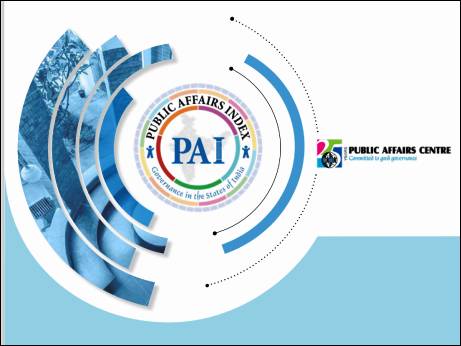
October 31 2021: Southern states, Kerala, Telangana and Tamil Nadu are tops in governance again. Karnataka is way behind at number 7 after Chattisgarh, Gujarat and Punjab.
Among smaller states, Sikkim, Goa,Mizoram and Himachal Pradesh are the top 4 states. Among Union territories, top performers are Puducherry, Dadra/NagarHaveli, Daman/Diu, Lakshadweep and Jammu and Kashmir.
The Public Affairs Index , the annual assessment of the adequacy and quality of Governance in the States of India has released its rankings for 2021.
On the basis of a Composite Index, the States are ranked on Governance performance. PAI 2021 is a non-partisan, independent and evidence-based study using only Central Government Data available in the public domain. It eradicates subjective biases in computation of the Index i.e. the results thus generated are computer generated using the scientifically rigorous methodology of Principal Component Analysis (PCA).
PAI 2021 looks at Governance performance in the context of sustainable development defined by three Pillars – Equity, Growth and Sustainability, five Themes, 14 SDGs and 43 indicators. Apart from the Pillar-wise rankings and analysis,
PAI 2021 also features an assessment of the effectiveness of implementation of five|
Centrally Sponsored Schemes-Mahatma Gandhi Rural Employment Guarantee Scheme (MGNREGS), National Health Mission (NHM), Integrated Child Development Services (ICDS), Samagra Siksha Abhiyan (SmSA) and Mid-Day Meal Scheme (MDMS).
Highlights of the Report:
Andhra Pradesh have slipped in rankings as compared to last year
Maharashtra that ranked 7th last year has slipped to 12th (drastic fall in the Equity Pillar from 6th to 15th), a clear indication that the state is struggling to recover from the pandemic. One of the surprise element has been the state of Jharkhand which has seen a very good improvement from 15th to 9th, while ranking 3rd in the Growth Pillar
Some of the key findings from PAI 2021 are:
The Cluster Analysis:The data analysed and the findings grouped the States of India into three clusters as shown below:
The 1st Cluster includes the Large States-Kerala, Haryana, Punjab and all the Small States including Arunachal Pradesh, Delhi, Goa, Himachal Pradesh, Manipur, Meghalaya, Mizoram, Nagaland, Sikkim, Tripura and Uttarakhand. This cluster appears to be driven by the Growth Pillar. The aforementioned States have performed well in terms of Structural transformation from the Agriculture sector to the Non-farm sector. It is also seen that these States have shown better performance in terms of
Health and Education outcomes driving their performance ii.
The 2nd Cluster includes nine Large States - Andhra Pradesh,Chhattisgarh, Gujarat, Karnataka, Madhya Pradesh, Maharashtra, Rajasthan, Tamil Nadu and Telangana. This cluster is driven by its performance in the Sustainability Pillar. The States show an improved performance in terms of community participation towards managing the solid waste generated, higher percentage of households using clean cooking fuel aiding in maintaining low PM10 levels
The 3rd Cluster consists of Assam, Bihar, Jharkhand, Odisha, Uttar Pradesh and West Bengal. This Cluster is characterised by moderate performance in the Growth Pillar and poor performance in the Equity and Sustainability Pillars. These States struggle in terms of providing basic infrastructure such as sanitation, drinking water, clean cooking fuel etc., Uttar Pradesh and Bihar have also shown poor performance in terms of addressing Crimes against Women and Minorities with highest number of Dowry Deaths and Rapes cases registered (NCRB, 2019). It is interesting to note that 57 out of the 112 districts which account for 50.8% of the total aspirational districts identified by NITI Aayog fall under the six States under this cluster, thereby it is safe to label this cluster as a poor performing.
PAC is a not for profit Think Tank established in 1994 with a mandate to improve the quality of governance in India.
Full report here.Press Release here